What if we could get 100,000s of people to learn a made-up language on Duolingo? 🤪
That’s exactly what I did, and I’ll share with you the strategy and tactics to get a huge number of enrollees and grow your community. Get ready!
Contents
Why it happened: The unlikely success story behind a growth engine
Let’s reveal the cool kid: Today’s protagonist is Esperanto, an artificial language that seemingly nobody speaks and most have never heard about. 😅 Alright, that doesn’t look great. But who cares? Let’s get one million people to learn it.
Esperanto hides amazing benefits. It’s the world’s most creative language (it works like LEGO pieces!) and is super fun to learn. Also, scientific experiments prove it helps you learn new languages up to 50% faster while increasing your chances of success by about 1/3.
However, even if you convinced a million people to start learning today, the results would be close to zero. The lack of qualified teachers and proper materials is one of the main growth constraints.
And unless you make learners an active part of the community, getting tons of them means little.
Proof of this is that the law in Hungary requires university students to obtain an intermediate certificate of two foreign languages, which organically transforms into thousands of people opting for Esperanto each year because that level can be reached in just 100-150 hours. And yet, they evaporate because the teachers don’t teach them what to do with the language.
So honestly, focusing on activation and retention makes more sense than making a giant effort on acquisition and throwing people into the void.
This is what I did about it:
Leverage a strategic partnership with Duolingo to increase completion rates
Duolingo was becoming the world’s most popular language-learning platform by offering free online courses designed to maximise effectiveness and engagement through scientifically proven solutions, such as gamification, high-frequency vocabulary, proactive reminders, etc.
That means it’s easier to convince people to start a course there, and primarily that more people will finish it.
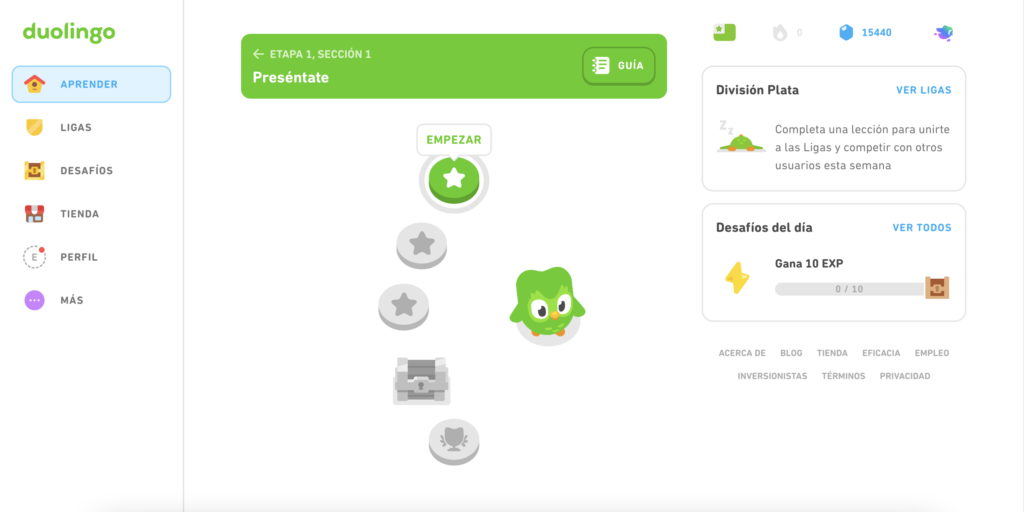
Completion rate is the most important metric in an online course because it represents people are being successful, as I learned from a Platzi’s co-founder. If you have a learning platform, you should consider setting a KPI (≈ target metric) for it.
We wanted to play the Duolingo advantage by using its technology to help fix a critical weakness in our community growth engine: The learner’s journey.
Chuck Smith led the release of the English course, and I was on the founding team for the Spanish one, co-developing 1,947 lessons, packaged in 379 levels across 45 units. That was a total of 2,383 words and 8,464 sentences in the curriculum.
Put in plain text: If you finish that course, you can have a real conversation in Esperanto.
We got approximately 2,000 new enrollees and 100 course finishers every day, appointing to a 5% completion rate. But hey, was that any good? Compare it with the astonishing 99.5% failure rate of pupils who learn foreign languages at schools in the United States. Our course was crushing it.
Duolingo invested money in our volunteer craft, e.g. doing professional voice recording of tons of sentences in a studio, and training machine learning models to implement voice recognition so that enrollees could practise.
Adapting the materials to be dialect-friendly (localisation) was an important yet attention-greedy task.
Create massive exposure to increase trialists
Duolingo was not just a technology-education partner, but a shop window (one-to-many model) thanks to its rapidly increasing user base (34+ million monthly active users now). Those who were using or heard about the platform could visit a gallery of courses, which represented millions of dollars in free advertising for us.
We also practiced cxeestismo (be where your audience is) because we learned that polyglots are particularly receptive to our product for several reasons.
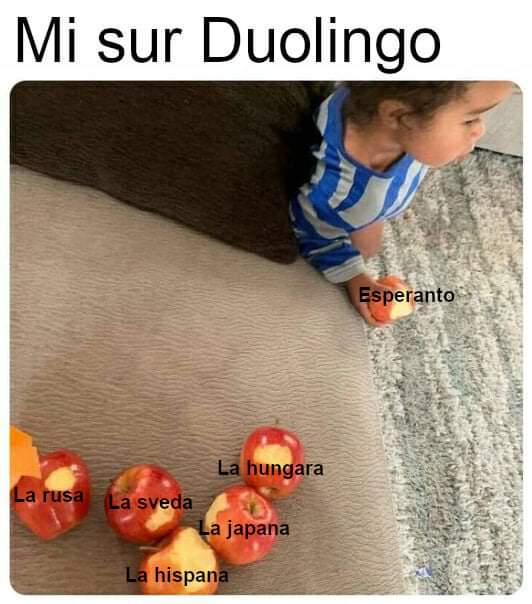
Meanwhile, a team of paid specialists worked on giving it more visibility. For example, its SEO team outreached many website owners to get backlinks (i.e., links to the course) to rank higher on Google.

As a community advocate, I learned that trials are of one the best-performing actions we could optimise for, and Duolingo made that easy and was helping us get 100,000s of them. That was a double-win multiplier: Many get hooked if they first try the language, while many more finish the course using Duolingo.
Leveraging other people’s networks is a growth model that has worked many times in my life.
If you’re creating a course for a target price below $100, I recommend considering an external platform, mostly if you don’t have a big database of emails yet because promotion is at least half of the job of creating a course.
For instance, Udemy promotes courses through paid ads, which you can consider as trading a commission of your sales in exchange for in-platform and off-platform visibility with the help of marketing specialists, as well as getting the course hosted for free.
Overall, it tends to be better to create an impact in people’s lives than to own everything (100% of nothing is still nothing).
Promote a new messaging to highlight benefits and growth
The course’s landing page helped refresh and spread a new sales pitch, focused on the benefits, and far from the traditional messaging around the founder in the 19th century.
It contained social proof, a best-in-category identification (most popular planned language) and highlighted benefits.
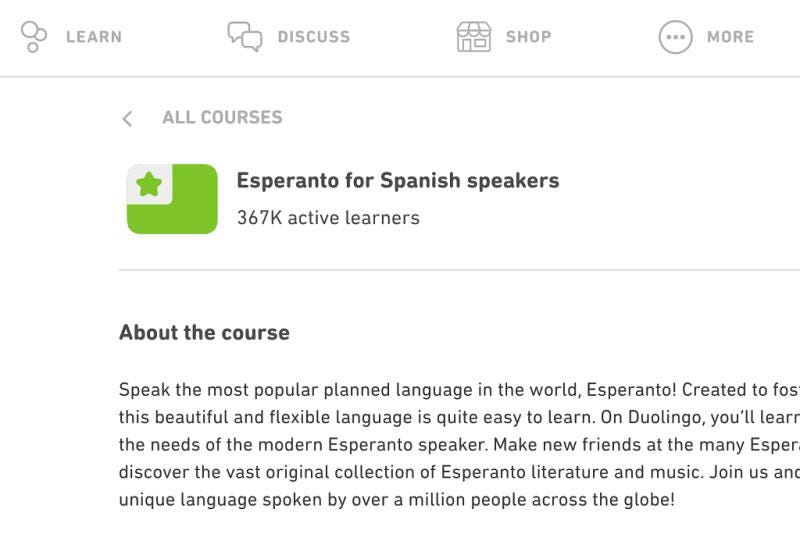
This helped a lot to build more trust and authority because prior to Duolingo, it was hard to answer the question of how many people speak it without relying on outdated and not very reliable sources.
At the same time, the number of enrollees continued to climb, which built excitement around the language and created buzz. Also, it fostered a sense of community due to the achievements and contributions of not only the creators but also all those who talked about it.
And, since growth attracts more attention than big numbers alone, that also made for shiny media attention.
Generate viral growth through word of mouth
Way before the course was ready, a waiting list was opened offering visitors to be the first ones to try it, and we amassed 10,000s of pre-enrollees. This was followed by a soft launch in which only those on the waiting list were able to start the course.
The temporary exclusivity made many learners share on social media that they got a pass, which made others feel Fear Of Missing Out (FOMO) if they weren’t learning it. And when the hard launch arrived, those first enrollees encouraged their friends to join (languages are a social product after all).
Important to note, that also gave us time to refine the course before it was publicly available.
Some people kicked off their own initiatives, helped by the flow of new learners and speakers. For example, monthly events with only people who were learning the language on Duolingo, the Universa Paralelo day event happening in many cities at the same time, social media movement marketing campaign when covid hit, and the Duolingo Generation video to show the faces of real people
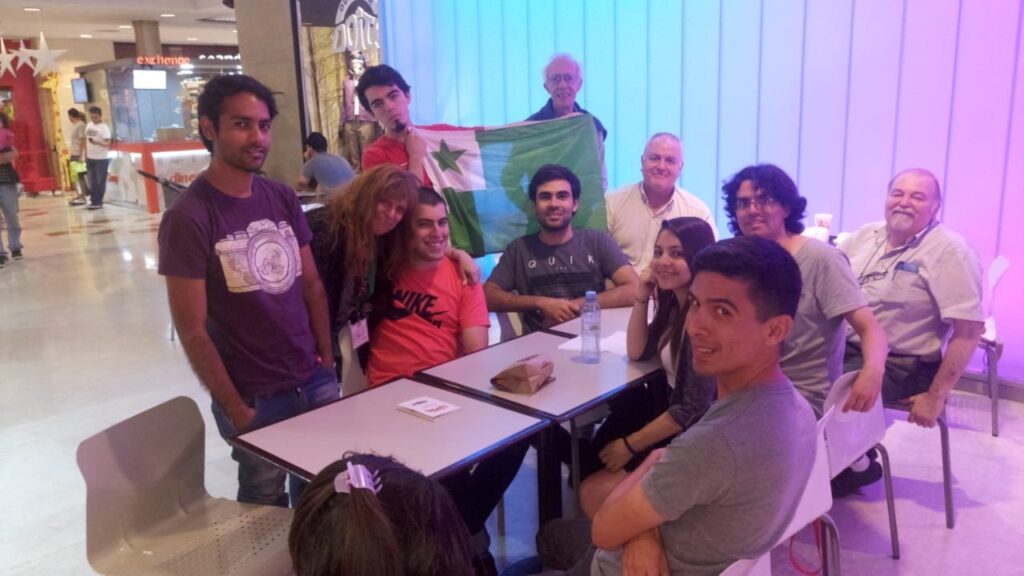
Another component of Product-Led Growth (PLG) was the success screens that encouraged learners to celebrate their accomplishments on the internet.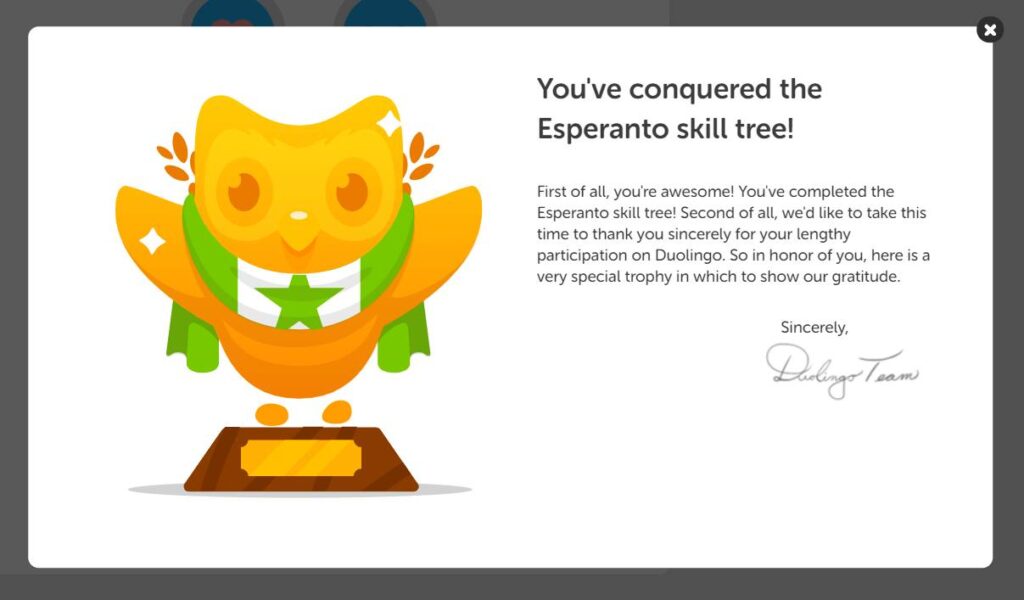
Overall, existing Duolingo users accessing the gallery of available courses (or in the incubator, too) was the main growth lever for the course to gain enrollees.
Foster community engagement
In order to immerse kursfinintoj (those who finished the course) into the Esperanto community, we promoted a landing page to ship them a free copy of the two most read magazines in Esperanto, with worldwide delivery. That helped make the language more tangible as well as collect contact information.
I put my focus on the data to create a new service to feed national associations and local organisers with potential WhatsApp group members and event participants.
That was done by full-time paid volunteers in the Netherlands following a simple process to gather the data into a Google Spreadsheet (that also operated as a kanban) and sending a template-powered email to the most relevant person in a global network database. That also strengthened the functional collaboration of the federation providing this new service.
Both creators and those who were taking the course participated in our Duolingo forum to reply to other learners’ questions and share their favourite resources, leading to valuable User-Generated Content (UGC).
We also added links to relevant social resources, such as national websites and online chat groups arranged by interest and location, e.g. across Facebook groups.
A small addition was our own community on Facebook, which got 4,200 members.
We also spread the word of some great opportunities, like Konkurso Partoprenu IJK, a program that allows a few people each year to attend the largest youth festival for free.
Double down on what works to grow faster
In an attempt to make Duolingo’s course the category leader, some colleagues took over to create a Portuguese and French version of the course afterward, with a Chinese one on the way.
Organisations started to move away from recommending a ton of options to a few or just one on their website: Duolingo. That was a necessary step to reduce the paradox of choice paradox (more options lead to paralysis, meaning fewer people started a course) and to palliate post-purchase rationalisation (preventing people from switching between courses and not finishing any).
Both offline teachers and groups of friends made the most of the app through Duolingo for Schools, which allowed everyone to create a class and compete to see who was winning and who was lagging behind. Interestingly, a few teachers took the tool as a primary tool and only met with students to reply to questions and practice.
Prevent a single point of failure
After some years of having the Esperanto courses on Duolingo, the company decided to switch from a crowdsourcing model to a fully in-house one. Sadly, the focus moved to the most profitable languages, and the continuous development of our courses stopped.
However, it was easier to convince other platforms to adopt Esperanto in the meantime. After all, if the biggest one had it, would they miss out? An example is Drops.
In parallel, we continued with open-source projects to build internal capacity. For example, Georg Jähnig modernised Esperanto In 12 Days, a course that focuses on high-frequency linguistic elements, and I made it available for Spanish speakers.
Keep optimising for retention
I believe we still lost most of the community members we could have gotten if we kept optimising for activation and retention.
When you learn what organisations like Greenpeace (largest environmental one) and AEGEE (largest one for students) do, it’s easy to see what best practices they follow, as well as all the lost opportunities we were reproducing.
For example, we didn’t have a central database where people could join (like Greenwire), didn’t create a handbook on how to welcome and engage newcomers on a local level, didn’t embed a kursfinintoj model inside other courses, and a very long etcetera.
The lack of a real international strategy and tools for local activists are among the top reasons Esperanto is not a 10X success. Those help understand why a large number of learners didn’t heavily impact the growth among traditional national and local groups.
Gamify the creators’ experience
Everyone involved in crowdsourcing models knows the hardest part of getting people to take action is commitment. That’s one of the reasons why Greenpeace’s campaigns are so much about signing petitions instead of focusing on direct action.
Duolingo’s model and lead volunteers avoided common mistakes by nudging through the system. This is what they did:
Co-creating a course required a long-time commitment, both before and after it was be released, so it all started with a direct question of how many hours per week each person could contribute. There was no way 1-2 people could do all the required work.
Some people put in more hours than others, as you could expect, but there was a public “hall of fame” page featuring the creators that highlighted the percentage each person contributed. This gamified the creators’ experience because nobody wanted to be the lazy ass in front of thousands of people (we were at stake), and we nudged ourselves to keep committing several hours per week. Instead, we all wanted to be the hero.
Crowdsourcing doesn’t mean no monetisation
The course was for free, however Duolingo monetized through paid perks for users. Unfortunately, paid certification was only implemented for a few languages despite the benefit for both monetisation, retention and distribution it could’ve driven.
Course creators initially did volunteering work, but the company compensated us a few years later when it dropped its integral scheme by switching to a centralised model, and paid authors – together with a home-delivered trophy.
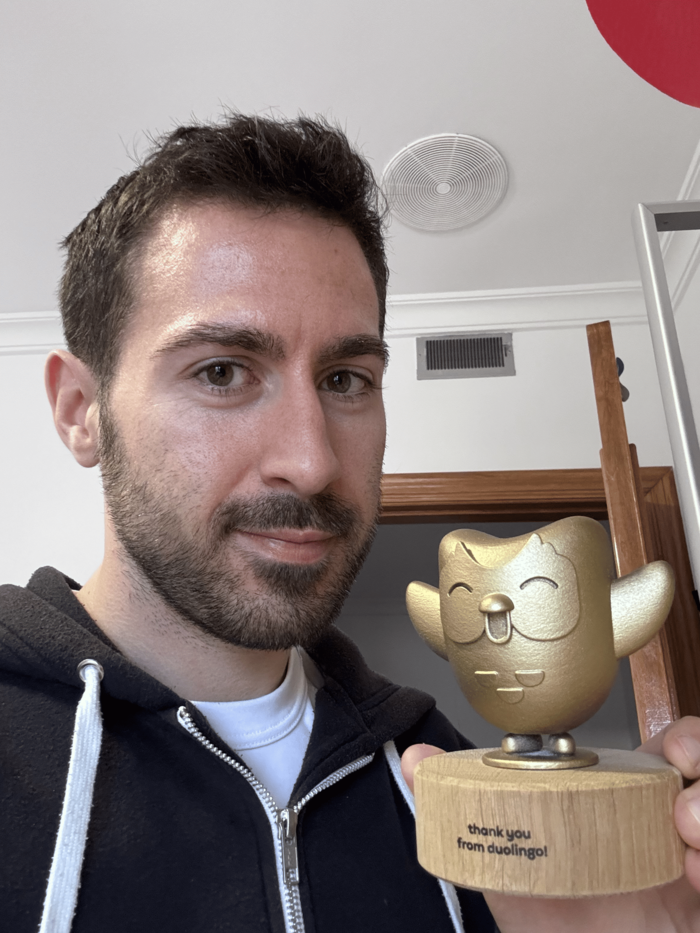
I believe it was around $1,000 per each percentage authors contributed to. So if you were a course creator with 20% of the contributions, then you got $20,000, and tax-free because it was considered a donation.
Some teachers emerged on platforms like Italki to help Duolingo learners reach conversational levels, providing additional support. I personally cashed in some dollars with a two-people class.
I also promoted my free online resources to learn Esperanto, and got some extra cash via ads through Google AdSense.
Duolingo paid the rent both directly and indirectly.
Conclusion
We built one of the most popular Esperanto courses with a peak at 367,000 simultaneous active learners (and probably 700,000+ enrollees over time), with at least 36,500 completions.
Building on the top of Duolingo gave us access to technology and its network of users to both provide better education and get a lot of free exposure, reaching 1.7 million enrollees across its different versions. Plus, it continued to improve over time, like when shipping time-decay flashcards.
The success of the Esperanto course wasn’t just about getting people to enrol through a one-to-many strategy, but about activating newcomers and building a sustainable community around the language.
What is your lesson #1 when creating a learning community?
Thanks to Sebastian Arismendi, Agustina Kaspin and Sergio Nistal for reviewing this article.

Growth marketer.
Be First to Comment